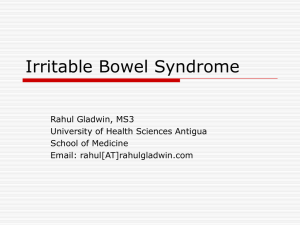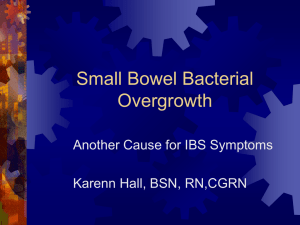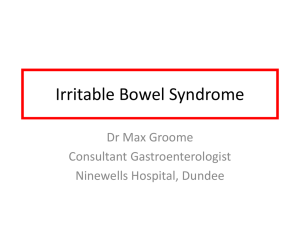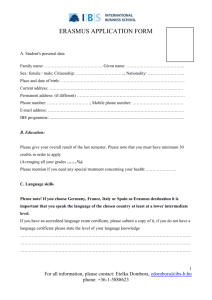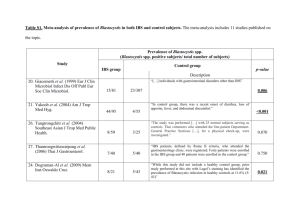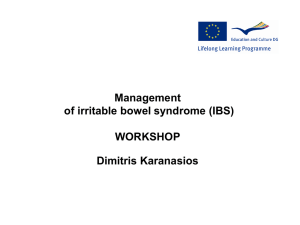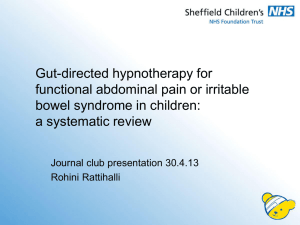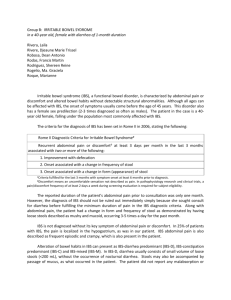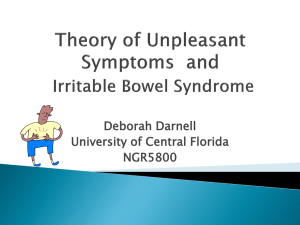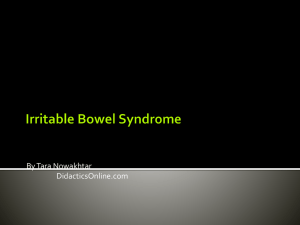View/Open
advertisement
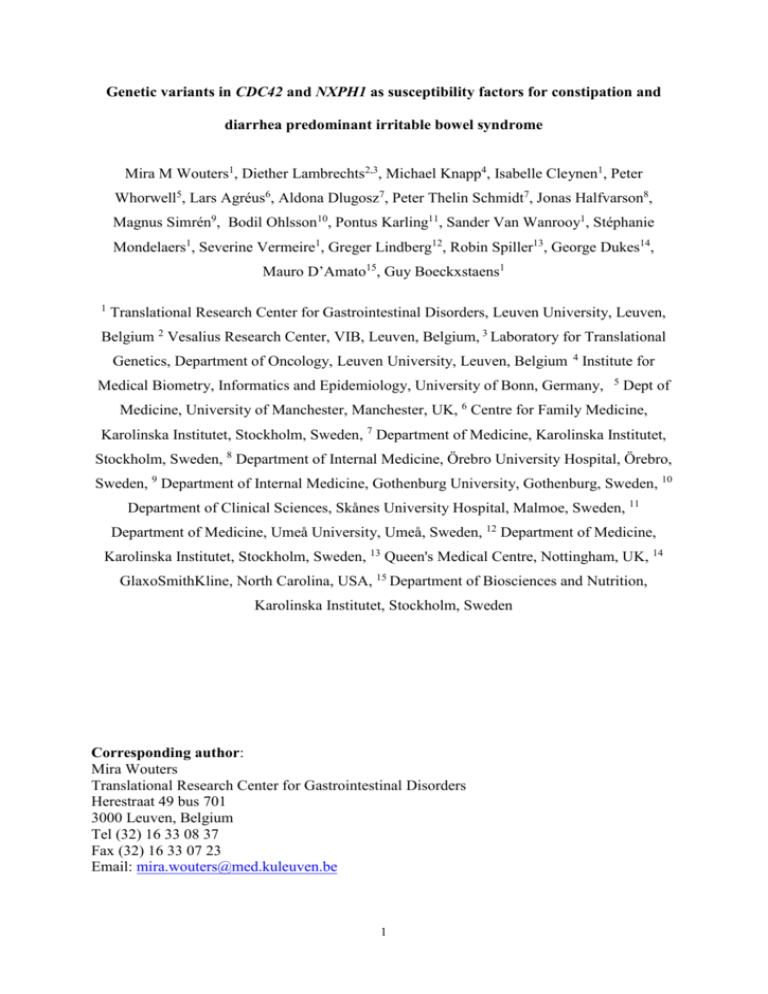
Genetic variants in CDC42 and NXPH1 as susceptibility factors for constipation and diarrhea predominant irritable bowel syndrome Mira M Wouters1, Diether Lambrechts2,3, Michael Knapp4, Isabelle Cleynen1, Peter Whorwell5, Lars Agréus6, Aldona Dlugosz7, Peter Thelin Schmidt7, Jonas Halfvarson8, Magnus Simrén9, Bodil Ohlsson10, Pontus Karling11, Sander Van Wanrooy1, Stéphanie Mondelaers1, Severine Vermeire1, Greger Lindberg12, Robin Spiller13, George Dukes14, Mauro D’Amato15, Guy Boeckxstaens1 1 Translational Research Center for Gastrointestinal Disorders, Leuven University, Leuven, Belgium 2 Vesalius Research Center, VIB, Leuven, Belgium, 3 Laboratory for Translational Genetics, Department of Oncology, Leuven University, Leuven, Belgium 4 Institute for Medical Biometry, Informatics and Epidemiology, University of Bonn, Germany, 5 Dept of Medicine, University of Manchester, Manchester, UK, 6 Centre for Family Medicine, Karolinska Institutet, Stockholm, Sweden, 7 Department of Medicine, Karolinska Institutet, Stockholm, Sweden, 8 Department of Internal Medicine, Örebro University Hospital, Örebro, Sweden, 9 Department of Internal Medicine, Gothenburg University, Gothenburg, Sweden, 10 Department of Clinical Sciences, Skånes University Hospital, Malmoe, Sweden, 11 Department of Medicine, Umeå University, Umeå, Sweden, 12 Department of Medicine, Karolinska Institutet, Stockholm, Sweden, 13 Queen's Medical Centre, Nottingham, UK, 14 GlaxoSmithKline, North Carolina, USA, 15 Department of Biosciences and Nutrition, Karolinska Institutet, Stockholm, Sweden Corresponding author: Mira Wouters Translational Research Center for Gastrointestinal Disorders Herestraat 49 bus 701 3000 Leuven, Belgium Tel (32) 16 33 08 37 Fax (32) 16 33 07 23 Email: mira.wouters@med.kuleuven.be 1 Keywords: irritable bowel syndrome (IBS), genetic variant, IL-13, NXPH1, CDC42 Word count: 3791 words The Corresponding Author has the right to grant on behalf of all authors and does grant on behalf of all authors, an exclusive licence (or non exclusive for government employees) on a worldwide basis to the BMJ Publishing Group Ltd and its Licensees to permit this article (if accepted) to be published in Gut editions and any other BMJPGL products to exploit all subsidiary rights, as set out in our licence 2 Abstract Objective: The complex genetic aetiology underlying irritable bowel syndrome (IBS) needs to be assessed in large-scale genetic studies. Two independent IBS cohorts were genotyped to assess whether genetic variability in immune, neuronal and barrier integrity genes is associated with IBS. Design: 384 SNPs covering 270 genes were genotyped in an exploratory cohort (935 IBS patients, 639 controls). 33 SNPs with Puncorrected<0.05 were validated in an independent set of 497 patients and 887 controls. Genotype distributions of single SNPs were assessed using an additive genetic model in IBS and clinical subtypes, IBS-C and IBS-D, both in individual and combined cohorts. Trait anxiety (N=614 patients, 533 controls), lifetime depression (N=654 patients, 533 controls) and mRNA expression in rectal biopsies (N=22 patients, 29 controls) were correlated with SNP genotypes. Results: Two SNPs associated independently in the exploratory and validation cohort: rs17837965-CDC42 with IBS-C (ORexploratory=1.59[1.05-1.76]; ORvalidation=1.76[1.03-3.01]) and rs2349775-NXPH1 with IBS-D (ORexploratory=1.28[1.06-1.56]; ORvalidation=1.42[1.081.88]). When combining both cohorts, the association of rs2349775 withstood post-hoc correction for multiple testing in the IBS-D subgroup. Additionally, 3 SNPs in immunerelated genes (rs1464510-LPP, rs1881457-IL13, rs2104286-IL2RA), one SNP in a neuronal gene (rs2349775-NXPH1) and 2 SNPs in epithelial genes (rs245051-SLC26A2, rs17837965CDC42) were weakly associated with total-IBS (Puncorrected<0.05). At the functional level, rs1881457 increased IL13 mRNA levels, whereas anxiety and depression scores did not correlate with rs2349775-NXPH1. Conclusion: Rs2349775 (NXPH1) and rs17837965 (CDC42) were associated with IBS-D and IBS-C, respectively, in two independent cohorts. Further studies are warranted to validate our findings and to determine the mechanisms underlying IBS pathophysiology. 3 Significance of the study What is already known about this subject? Previous studies showed that IBS exhibits the typical features of a complex multifactorial disorder influenced by both environmental and genetic factors Defects in mucosal barrier integrity, inflammation and immune interactions with bacteria in the gut, neuronal sensitization (altered nociceptor expression, increased anxiety and depression) and altered motor function are emerging as candidate genes contributing to the pathogenesis of IBS Although TNFSF15 variants have repeatedly been associated with IBS, genetic studies in IBS have been largely inconclusive due to small sample sizes. What are the new findings? Two SNPs, rs17837965 in CDC42 and rs2349775 in NXPH1, were associated with IBS-C and IBS-D respectively, in two independent cohorts of 1432 IBS patients and 1526 controls The rs2349775 variant in NXPH1 withstood post-hoc correction for multiple testing in the combined IBS-D subgroup, suggesting that it represents a true susceptibility factor for IBS How might it impact on clinical practice in the foreseeable future? Our data may contribute to the identification of important targets in IBS which may ultimately result in improved clinical management 4 Background Irritable bowel syndrome (IBS) is a multifactorial disorder, which is more common in women and presents with a variety of symptoms, including altered bowel habits, bloating and increased abdominal pain sensation (1). As IBS diagnosis is based on symptoms, it consists of several clinical subtypes including constipation predominant IBS (IBS-C), diarrhea predominant IBS (IBS-D) or alternating constipation and diarrhea IBS (IBS-A) with potentially different underlying pathophysiological pathways. Diet, psychological distress, infections, low-grade inflammation and immunological alterations, dysregulated interactions with potentially altered microbiota, sensitization/upregulation of nociceptors and changes in intestinal motility and altered gut-brain communication have all been proposed as contributing factors (2-4). Epidemiological studies of familial aggregation (5;6) and twins (7-11) suggest that genetic predisposition may explain up to 22-48% of the incidence of IBS. However, these data are conflicting as Mohammed et al demonstrated that social learning has an equal or greater influence (12). Moreover, environmental risk factors such as psychological stress, smoking and the use of antibiotics (8) significantly contribute to IBS susceptibility as well. Overall, IBS exhibits typical features of a complex genetic disorder influenced by both environmental and genetic factors. Although our current knowledge on genetic predisposition to IBS is very limited, a number of studies already assessed the risk effects of single nucleotide polymorphisms (SNPs) in candidate genes. One study reported that SNPs in TLR9, IL6 and CDH1, which are involved in immune activation and epithelial barrier integrity, were nominally associated with post-infectious IBS (PI-IBS) (13). Another study focused on functional gastrointestinal disorders and correlated colonic transit rate and pain sensation with polymorphisms in the neuropeptide S receptor gene (NPSR1) (14), a gene involved in inflammation, anxiety and nociception. In the largest genetic study of IBS so far, a strong 5 association was reported between rs4263839 in TNFSF15 (15), which is involved in Th17 immune response, and IBS (particularly IBS-C) in two independent cohorts from Sweden and USA. Although with a different subtype (IBS-D) and with another SNP, this association was recently replicated in UK individuals (16). Additional smaller studies identified SNPs in serotonergic genes (17-21) and inflammatory genes (22-24) as susceptibility SNPs for IBS. All genetic variants previously associated with IBS have been reviewed elsewhere (25-27). In view of the diversity of IBS aetiologies and phenotypic subtypes (IBS-A, IBS-C, IBS-D, PI-IBS), there is a great need for much larger studies systematically evaluating genetic variants in IBS. We therefore evaluated genetic predisposition to IBS, using a hypothesisdriven genetic association approach with validation in an independent cohort (except for the genes that were already reported in this validation cohort). In particular, 384 variants located in 270 genes involved in immune modulation, inflammation, motor function, pain processing, nociceptor sensitization, altered neuronal function (centrally and peripherally) and epithelial barrier integrity were genotyped in a cohort of 1432 IBS patients. 6 Subjects and Methods Study populations Two independent cohorts of IBS patients and controls from UK/US/Canada and Sweden were included in this study. Informed consent was obtained from all participants and local ethics committees approved the study protocol. The demographics and clinical characteristics of both cohorts are reported in Table 1. The IBS patients were divided into subgroups based on the predominant bowel habit according to the Rome II criteria (1). Exploratory cohort: This cohort consisted of 935 IBS patients and 639 controls from the UK, US or Canada. All patients confirmed Caucasian ethnicity. IBS patients were included if they had a history of IBS for at least 6 months according to Rome II criteria. IBS patients had a colonoscopy/barium enema during the last 12 months with normal results, supporting an IBS diagnosis. Controls were included if they had no previous IBS diagnosis (based on physician assessment and negative Rome II criteria) and no former history of chronic GI diseases. Controls were matched to IBS patients according to age (+/- 5 years), gender, ethnicity and referring physician, where feasible. All samples from the exploratory cohort were kindly provided by Glaxo Smith Kline (UK). Validation cohort: 497 IBS patients were recruited from primary, secondary and tertiary care centres and clinics in Stockholm, Gothenburg, Malmoe and Kalix-Haparanda in Sweden. The diagnosis of IBS was based on Rome II criteria and symptom phenotypes, consensus criteria and validated questionnaires of gastrointestinal and somatic symptoms. 887 Controls were healthy blood donors free of gastrointestinal complaints and inflammatory disease. Genotyping To select genetic variants in genes involved in immune modulation, inflammation, motor function, pain processing, nociceptor sensitization, altered neuronal function (centrally and peripherally), we performed a systematic review using the public database PubMed: with 7 highest priority, we included SNPs previously characterized and potentially associated with IBS in serotonergic pathways, immune responses, and intestinal epithelial barrier and motor function (13-15;17-22;28-30) (keywords “Irritable bowel syndrome” and “SNP” or “genetic variant”). Next, using the same overall approach, we selected SNPs that were previously identified as susceptibility variants in independent association studies of diseases with potentially comparable underlying pathophysiological mechanisms (keywords were “SNP” or “genetic variant” and the following disease: diseases mediated by aberrant immune activation and/or inflammation: Crohn’s disease, ulcerative colitis, type 1 diabetes, rheumatoid arthritis, multiple sclerosis, chronic obstructive pulmonary disease, ankylosing spondylitis, hyper IgE syndrome, barrier dysfunction related diseases: celiac disease and diseases due to altered neuronal function: anxiety, major depression, somatic pain sensation). Finally, we also selected SNPs based on a HAPMAP tagging approach (www.hapmap.org) in tight-junction genes, nociceptors such as TRP genes, Toll-like receptors, NOD-like receptors and cytokines (see list of selected SNPs in supplementary Table 1). In total, 443 SNPs were selected, evaluated and scored by the Illumina Technical Support Service for potential genotyping using Illumina Golden Gate. SNPs with a GGGT score lower than 0.6 were excluded. Likewise, we excluded tagging SNPs if more than 4 tagging SNPs per gene were selected. Of the remaining 384 SNPs, 318 SNPs had a GGGT score above 0.8 and 66 SNPs had a GGGT score between 0.6 and 0.8. The final 384 SNPs included 25 SNPs that were previously associated with IBS (1315;17-22;28-31), 265 SNPs that were previously identified as susceptibility variants for immune mediated diseases, genes involved in barrier dysfunction related diseases and neuropathologies and 94 SNPs were selected based on the SNP tagging approach. Out of the 384 SNPs, 19 SNPs had a minor allele frequency <0.05 in the CEPH population (Utah residents with Northern and Western European Ancestry, CEU). 8 Samples from the exploratory cohort were genotyped with custom-designed oligo chips using Illumina Golden Gate (Vesalius Research Center, KULeuven). Based on the results of this exploratory study, SNPs nominally associated with total IBS, IBS-C or IBS-D with Puncorrected<0.05 were selected for validation in the Swedish cohort by Sequenom® MassARRAY (Fig. 1). Quality control (QC) criteria for Golden Gate and Sequenom®MassARRAY genotyping included: a SNP call rate of >0.95 in patients and controls, a sample call rate >0.95, a minor allele frequency (MAF) of >0.01 and a HardyWeinberg equilibrium- (HWE-) p-value of >0.0001 in controls and >0.00001 in cases. The STAI Trait anxiety and depression questionnaires and the mRNA expression analysis in colonic biopsies of the exploratory cohort are described in supplementary Material and Methods. Statistical analyses Fisher's exact tests were used to test for Hardy-Weinberg Equilibrium (HWE). For the analysis of individual SNPs, we used the Cochran-Armitage trend test under the assumption of an additive genetic model and Plink v1.07 software (http://pngu.mgh.harvard.edu/~purcell/plink/). Furthermore, we performed a Cochran-MantelHaenszel meta-analysis in the combined cohort using the Statistical Analysis Software (SAS) (http://www.sas.com). Analyses were performed for all IBS patients and two IBS subgroups (IBS-C and IBS-D). The 140 IBS-A samples in our exploratory cohort did not provide enough power to detect statistical significance. SNPs with p<0.05 in the IBS-A subgroup were therefore not further validated. SNPs with a Puncorrected<0.05 in the exploratory cohort were selected for follow-up analysis in the validation cohort. To correct for multiple testing (33 SNPs in 3 IBS groups, i.e., total IBS, IBS-C and IBS-D), a p-value <5E-04 was considered 9 significant. In addition, False Discovery Rate (FDR) correction was applied for the number of SNPs per IBS subgroup (Figure 2-4, supplemental Table 1-3) (R project software v2.15; http://www.r-project.org/). Linkage disequilibrium (LD) between markers in the two studied populations was based on HapMap data using Haploview 4.2 software (http://www.broadinstitute.org/haploview). The CaTS Power Calculator for Two Stage Association Studies was used for power calculations. RT-qPCR results, trait anxiety and depression scores were analyzed with Graphpad Prism software (GraphPad Software, Inc., La Jolla, CA) using the Mann–Whitney U-test for unpaired samples. 10 Results Genetic variants associated with IBS Out of 384 SNPs, 21 SNPs failed our quality control due to low call rates, while another 6 SNPs were excluded because they were monomorphic. All remaining 357 SNPs were subsequently assessed for association with IBS and its different clinical subtypes (935 IBS patients, of which 430 had IBS-D and 325 had IBS-C, and 639 controls) in our exploratory cohort. Genotype distributions and association results of all SNPs are reported in Supplemental Tables 4-7. Total IBS In total, eighteen SNPs were weakly associated (Puncorrected<0.05) with total IBS in the discovery cohort (supplemental Table 5). The rs744166 variant in STAT3 was previously reported not to be associated with IBS in the validation cohort (15;28) and was therefore not replicated. Overall, 3 SNPs failed genotyping in the validation cohort: rs1758241 (unknown gene) was not further studied, rs3024505 (IL10) and rs1800925 (IL13) failed but nearby located SNPs rs1800896 (R2=0.253) and rs1881457 (R2=0.747) respectively - also identified in the exploratory cohort - were successfully genotyped. Only one SNP, rs4986791 near TLR4, was weakly associated (Puncorrected<0.05) with IBS in the exploratory and validation cohorts, but this SNP had opposite allelic effects in the two cohorts (ORExploratory=3.38 [1.537.44] and ORvalidation=0.47 [0.31-0.7]) (Fig. 2, sTable 1). Next, we combined the exploratory and validation cohorts and we assessed using a Cochran-Mantel-Haenszel meta-analysis whether SNPs associated significantly with total IBS (Fig. 2, sTable 1). Although none of the validated SNPs was resistant for multiple testing (P<5E-04), 6 SNPs were weakly associated at the uncorrected threshold (Puncorrected<0.05), namely rs1464510 in LPP, rs1881457 in IL13, rs245051 in SLC26A2, rs2349775 in NXPH1, rs2104286 in IL2RA and rs17837965 near CDC42 (Fig. 2, sTable 1, sFig. 1). 11 IBS subphenotypes All SNPs with a Puncorrected<0.05 in the IBS-C or IBS-D subgroup of the exploratory cohort were selected for validation. One SNP, namely rs17837965 in CDC42, was associated with IBS-C in both independent cohorts (PCMH IBS-C=2.88E-03; ORexpl=1.59 [1.05-1.76] and ORvalidation=1.76 [1.03-3.01]) (Fig. 3, sTable 2) and may represent a true association signal. Also for IBS-D, only 1 SNP, namely SNP rs2349775 (NXPH1), was associated with IBS-D in both cohorts. Moreover, rs2349775 was the only SNP that withstood post-hoc correction for multiple testing (PCMH IBS-D=4.62E-04; ORexpl =1.28 [1.06-1.56] and ORvalidation =1.42 [1.08- 1.88]) (Fig. 4, sTable 3) and that may therefore represent a true association signal. Functional analysis of the newly identified candidate SNPs Next, in an attempt to provide functional evidence that the 6 SNPs weakly associated with total IBS (Puncorrected<0.05) were functionally implicated in IBS pathophysiology, we correlated SNP genotypes with expression of their target genes. Because the function of SNP rs2104286 in IL2RA has already been reported in literature (i.e. rs2104286 modulates soluble IL2RA serum levels in healthy controls, MS and T1D patients (32)), this SNPs was not studied at the functional level. The neuronal gene NXPH1 was not detected by qPCR in rectal biopsies or PBMCs of neither IBS nor controls (n=3, data not shown). This SNP was therefore correlated with IBS comorbidity symptoms, i.e. anxiety and depression. 1. Association of NXPH1 with anxiety and depression NXPH1 (rs2349775) was previously associated with neuroticism (33) and was preferentially associated with IBS-D in our study. Trait anxiety was slightly higher in IBS compared to controls (IBS (n=614): 45 [IQR 42-48] vs controls (n=533): 44 [IQR 42-47], P=0.0002). There was no correlation between the rs2349775 (NXPH1) genotype and trait 12 anxiety (data not shown). Besides anxiety, IBS patients had higher life time depression scores compared to controls (IBS (n=654): 7, IQR 0-9 vs controls (n=533): 3 [IQR 0-8], P<0.0001). However, in IBS and controls, depression scores were not affected by the genotype of rs2349775 (NXPH1) (GG (n=79): 4 [IQR 0-9]; AG (n=448): 6 [IQR 0-9]; AA (n=586): 6 [IQR 0-9]). 2. Functional effect of rs1881457 on IL13 mRNA expression in rectal biopsies The rs1881457 SNP in IL13 is located on chromosome 5q31 in a genomic region containing a cluster of Th2 cytokine genes (IL13, IL4 and IL5). IL13 mRNA expression was quantified in rectal biopsies of 22 IBS patients and 29 controls where we compared the extreme phenotypes, wild type versus homozygous risk allele carriers. IL13 mRNA expression was significantly higher in the rs1881457 AA than in the CC genotype carriers (PMann Whitney U <0.0001; Fig. 5A). This effect was seen in IBS patients (PMann Whitney U =0.048; Fig. 5B) and controls (PMann Whitney U =0.0004; Fig. 5B). 3. Expression profiles in rectal biopsies of nominally significant SNPs in epithelial genes Although rs245051 in SLC26A2 is also located on chromosome 5q31, this SNP occurs independently of rs1881457 (IL13) (r2=0). There was no difference in SLC26A2 mRNA expression between IBS patients and controls (data not shown). Moreover, rs245051 did not affect SLC26A2 mRNA levels in IBS (data not shown). Finally, we were not able to assess the effect of rs17837965 on CDC42 mRNA expression due to a lack of biopsies exhibiting the less frequent GG genotype. 13 Discussion We demonstrated that genetic variants in CDC42 and NXPH1 were associated with IBS-C and IBS-D, respectively, in two independent cohorts. Only 1 SNP, namely rs2349775 (NXPH1), withstood post-hoc correction for multiple testing. Moreover, six novel potential candidate risk loci were weakly associated with IBS (Puncorrected<0.05) in the combined cohort, namely 3 SNPs in immune related genes IL2RA, IL13 and LPP, 1 SNP in the neuronal expressed gene NXPH1, and 2 SNPs in epithelial expressed genes SLC26A2 and CDC42. SNPs located in immune-related genes Immune activation or dysregulation has been proposed as underlying mechanism of IBS, especially following an episode of infectious gastroenteritis. Besides increased numbers of T cells and enteroendocrine cells in post-infectious IBS rectal biopsies (34), much attention has been given to the role of mast cells, monocytes and T cells in other IBS subtypes (2). We potentially identified three novel SNPs associated with IBS in genes with an immune function, namely rs2104286 in interleukin 2 receptor alpha (IL2RA), rs1464510 in Lipomapreferred partner (LPP) and rs1881457 in interleukin 13 (IL13). Rs1881457 in IL13 is located at chromosome 5q31 in the promotor region of IL13, a cluster of genes involved in Th2 immune response. Kiesler et al reported that the rs1881457 C allele, which is associated with allergic asthma, results in enhanced IL13 expression in vitro (35). In contrast, we found that the A allele was weakly associated with IBS and rs1881457*AA biopsies expressed more IL13 mRNA compared to rs1881457*CC biopsies, an effect seen in both IBS patients and controls. The A risk allele was present in 82 and 80% of IBS patients compared to 79 and 77% of controls in the exploratory and validation cohort respectively. Our cohort provided 62% power to detect a positive association (Puncorrected<0,05) for rs1881457. Altogether, our results indicate that IBS patients carry more A alleles compared to healthy individuals and carriers of this allele express more IL13 mRNA 14 compared to C allele carriers. Because rs1881457 is located in a dense, highly correlated region, we cannot deduct which SNP is causal or reflects other causal genetic variants. Nevertheless, we speculate that in a minority of IBS patients, genotypic variants in the Th2 cytokine cluster at 5q31 may contribute to IBS pathogenesis by increasing IL13 expression, possibly even more pronounced in response to pathogens or intraluminal antigens. Of note, although in yet another subset of patients (IBS-A) compared to the original observations (all IBS subtypes and IBS-C (15), or IBS-D (16)), we detected association with the TNFSF15 gene in the exploratory cohort (for SNP rs4263839: Ptrend=4.26E-02; SNP rs6478108: Ptrend=4.09E-02, supplemental Table 8). All IBS-A patients in the exploratory cohort derived from Canada or USA sites and did not include UK samples (16), hence this is truly a repeat. Genetic variation at this locus has now been repeatedly associated to IBS and its subtypes in four different case-control cohorts, namely from Sweden (15), USA (15), UK (16) and now in a US/Canada cohort, which strongly suggests this may be in fact the first true causative locus identified in IBS. SNPs in genes involved in neuronal functioning IBS patients have more psychopathology, particularly anxiety disorders and depression, compared to the general population (36). Rs2349775 in NXPH1 was previously associated with neuroticism (33). In two independent cohorts, rs2349775 in NXPH1 was associated with IBS-D (75% of patients vs 70% of controls in exploratory cohort, 77% of patients vs 70% of controls in validation cohort). This is the only SNP that withstood correction for multiple testing. In the IBS-D cohort, we had 79% statistical power to detect a positive association for this SNP (Puncorrected<0,05). In line with the available literature, lifetime depression (37) was increased in our exploratory IBS cohort compared to controls. However, rs2349775 in NXPH1 had no effect on depression or trait anxiety levels. Besides having central effects, secreted NXPH1 inhibits the proliferation of hematopoietic progenitor 15 cells involved in the immune response (38). We speculate that genetic variants in NXPH1 may alter the immune response to a gastrointestinal insult, resulting in low grade inflammation and diarrhea. However, the functional role of genetic variations in NXPH1 on IBS susceptibility and diarrhea needs to be further explored. SNPs in epithelial genes The epithelial lining of the intestine is crucial in maintaining tolerance and controls antigen exposure to the mucosal immune system. One of the mechanisms proposed to contribute to the pathophysiology of IBS is impaired intestinal barrier function (39). In the present study, we found a consistent association between rs17837965 in cell division cycle 42 (CDC42) and IBS-C in two independent cohorts (G allele in 6.5% patients vs 4.2% controls in exploratory cohort, 7.2% of patients vs 4.2% controls in validation cohort). CDC42 is associated with schizophrenia (40), is crucial for normal dendritic spine development in the brain (40) and is also involved in intestinal stem cell differentiation and proliferation (41). Intestinal stem cells lacking CDC42 undergo defective cell division, abnormal morphogenesis, elevated apoptosis, and failed Paneth cell differentiation (41;42), indicating that genetic variants in CDC42 may alter epithelial barrier function. Moreover, the loss of absorptive microvilli from the surface of small intestinal enterocytes (Caco-2 cells) in response to E. coli or its toxins was linked to CDC42 functionality (43). Additionally, CDC42 regulates epithelial membrane transport and secretion (41;44). Altogether, we speculate that genetic variants of CDC42 may alter secretion and/or barrier function, resulting in constipation. Rs17837965 GG carriers are rather rare (4-7%) making it difficult to perform functional studies aiming to dissect the functional effect of genetic variants in CDC42. Finally, we identified a weak association between SLC26A2 and IBS(-D). SLC26a2, is an ubiquitously expressed electroneutral SO(4)(2-) transporter with high expression levels in colonic epithelial lining (45;46). SLC26A2 is downregulated in Crohn’s disease (47) but there 16 was no difference in SLC26A2 mRNA expression between IBS and controls. Again, little is known about SLC26A2 and how genetic variants of SLC26A2 contribute to IBS remains to be evaluated. In summary, our data indicate that genetic variants in genes involved in neuronal processing (NXPH1), and epithelial barrier function (CDC42) might contribute to IBS pathogenesis. However, although our results are encouraging, it needs to be stressed that the SNPs identified in our study are weakly associated (Puncorrected<0.05) and despite biological plausibility may represent false positive associations. Hence, our findings are hypothesis-generating and still need to be confirmed in independent studies. We would like to emphasize, however, that they were identified in a much larger IBS population than normally is the case in the IBS field. We therefore believe that our studies may serve as a very valuable source to select and confirm candidate susceptibility SNPs or genes involved in IBS. Nevertheless, our study is limited by the fact that SNPs were often selected based on GWA studies focussing on diseases with potentially comparable underlying pathophysiological mechanisms as IBS. Therefore, our selection contained several intronic SNPs as well as SNPs with an unknown function or SNPs with an (yet) unclear contribution to IBS pathogenesis. Our current sample size provides 79% power to detect associations with a P value <5E-4 and a risk effect size of 1.25 and MAF of 0.40 (supplemental Table 10). To reach genome wide significance (α=10E-7), a two-stage approach with 5000 IBS patients and 5000 healthy controls would, for instance, be required to have 95% power to detect associations with SNPs having a MAF of 0.20 and risk of 1.25 with (genome wide significance). Such high number of patients was not available, and therefore an extensive hypothesis driven genetic association approach was used instead. As a result, none of the selected SNPs could be used as population-based markers to assess potential population stratification. Additionally, IBS diagnosis is very common (15%) in the general population; 17 IBS risk variants may therefore also be present in a significant proportion of controls. However, since we used controls that are free of IBS diagnosis, our results could sustain this bias and may become even more significant when comparing IBS patients to an ideal set of controls, which would consist of healthy volunteers devoid from any of the IBS inclusion criteria. Finally, in the future, the discovery of IBS disease genes may be complemented by studies focussing on endophenotypes underlying IBS, such as colonic transit and visceral pain. In conclusion, genetic variants in CDC42 and NXPH1 were associated with IBS-C and IBS-D respectively in two independent cohorts. Further studies are warranted to validate our findings and to determine the mechanisms by which these variants underlie IBS pathophysiology. 18 Table 1. Demographic and clinical characteristics of IBS patients and controls N Mean age, years Men/women Alternating (IBS-A) Constipation (IBS-C) Diarrhoea (IBS-D) Post infectious (IBS-PI) UK/US/Canadian cohort Control IBS 639 935 42.55±14.44 42.76±14.35 158/481 179/756 140 325 430 40 Sweden cohort Control IBS 887 497 45.67±12.30 44.28±13.35 553/334 107/390 218 118 161 19 Combined cohort Control IBS 1526 1432 358 443 591 40 Figure legends Fig. 1. Study design Fig. 2. Association of genetic variants with total IBS Shown from left to right are: Nearest gene with NCBI dbSNP database accession numbers (rs number) in the respective cohort (exploratory cohort (UK), validation cohort (SWE), and combined cohort (COMB), Armitage's Trend test (P_Trend), Cochran-Mantel-Haenszel meta-analysis (P_CMH), false positive report P_CMH (FDR P_CMH), allelic odds ratio (OR) and lower and upper bound of the corresponding 95% confidence interval (CI (95%)) * SNP was not associated with total IBS but with C-IBS in the exploratory cohort Fig. 3. Association results of genetic variants with constipation predominant IBS Shown from left to right are: Nearest gene with NCBI dbSNP database accession numbers (rs number) in the respective cohort (exploratory cohort (UK), validation cohort (SWE), and combined cohort (COMB), Armitage's Trend test (P_Trend), Cochran-Mantel-Haenszel meta-analysis (P_CMH), false positive report P_CMH (FDR P_CMH), allelic odds ratio (OR) and lower and upper bound of the corresponding 95% confidence interval (CI (95%)) Fig. 4. Association results of genetic variants with diarrhea predominant IBS Shown from left to right are: Nearest gene with NCBI dbSNP database accession numbers (rs number) in the respective cohort (exploratory cohort (UK), validation cohort (SWE), and combined cohort (COMB), Armitage's Trend test (P_Trend), Cochran-Mantel-Haenszel meta-analysis (P_CMH), false positive report P_CMH (FDR P_CMH), allelic odds ratio (OR) and lower and upper bound of the corresponding 95% confidence interval (CI (95%)) Fig. 5. IL13 mRNA expression is dependent on the rs1881457 genotype IL13 mRNA expression was decreased in the rs1881457 CC genotype compared to the AA genotype (A). In both IBS and controls, the protective C alleles resulted in decreased IL13 mRNA expression compared to the A risk alleles (B). There was no difference in IL13 mRNA expression in controls (ctrls) compared to IBS (B). Each dot represents an individual, the line represents the median. Author contributions: All authors read and approved the final version of the manuscript MMW: study concept and design, acquisition of data, analysis and interpretation of data; drafting of the manuscript DL: technical and material support, critical revision of the manuscript for important intellectual content MK: statistical analysis IC: analysis and interpretation of data, critical revision of the manuscript for important intellectual content LA, AD, PTS, JH, BO, PK, SVW, SM: acquisition of samples and characterization of patients 20 PW, MS, RS: acquisition of samples and characterization of patients, critical revision of the manuscript for important intellectual content SV: critical revision of the manuscript for important intellectual content GL: provided funding for validation phase, acquisition of samples MD: acquisition of data, critical revision of the manuscript for important intellectual content GD: obtained funding, acquisition of samples and data, critical revision of the manuscript for important intellectual content GEB: study supervision, obtained funding, critical revision of the manuscript for important intellectual content Grant support: GlaxoSmithKline Pharmaceuticals has supported the data collection and the provision of samples and data from the UK/US/Canadian cohort. This work was financially supported by research grant G.0699.10N from the Fund for Scientific Research (FWO) Flanders, Belgium. Mira Wouters and Isabelle Cleynen are postdoctoral researchers and Séverine Vermeire is a senior clinical investigator of the FWO. Guy Boeckxstaens received research funding by a grant from the Flemish government (Odysseus Program, FWO). Research activities in Sweden were supported by funds from the Swedish Research Council to Mauro D’Amato. Magnus Simrén was supported by the Swedish Medical Research Council (grants 13409, 21691 and 21692) and The Marianne and Marcus Wallenberg Foundation. Magnus Simrén has received unrestricted research grants from Danone and AstraZeneca, and served as a Consultant/Advisory Board member for AstraZeneca, Danone, Novartis, Almirall, and Shire/Movetis. Acknowledgements The authors would like to thank Dr. Theadore Ptak, Renee Henry, Ellen Goldstein, Cindy Lee, Deborah Roach, Jacqueline Rabuzin and Elizabeth Crosland (Toronto Digestive Disease Associates (TDDA Inc.), Toronto, Ontario, Canada), Dr. Mark Silverberg and Lori Baladjay (Mount Sinai Hospital, Toronto, Ontario, Canada), Dr. Yehuda Ringel, Dr. Robert Sandler, Alesia N. Aileo, Sarah Causey and Sarah Yeskel (University of North Carolina at Chapel Hill, NC, USA) for collecting samples and acquiring data and Dr. Rachel Gibson (GlaxoSmithKline) for logistic support. We thank all of the patients and the supporting staff at each site. Disclosures: The authors report no conflict of interest 21 22 Reference List (1) Longstreth GF, Thompson WG, Chey WD et al. Functional bowel disorders. Gastroenterology 2006;130(5):1480-91. (2) Ohman L, Simren M. Pathogenesis of IBS: role of inflammation, immunity and neuroimmune interactions. Nat Rev Gastroenterol Hepatol 2010;7(3):163-73. (3) Jeffery IB, O'Toole PW, Ohman L et al. An irritable bowel syndrome subtype defined by speciesspecific alterations in faecal microbiota. Gut 2011;61(7):997-1006(7):997-1006. (4) Camilleri M, Lasch K, Zhou W. The Confluence of Increased Permeability, Inflammation, and Pain in Irritable Bowel Syndrome. Am J Physiol Gastrointest Liver Physiol 2012;303(7):G775-85. (5) Saito YA, Petersen GM, Larson JJ et al. Familial aggregation of irritable bowel syndrome: a family case-control study. Am J Gastroenterol 2010;105(4):833-41. (6) Kalantar JS, Locke GR, III, Zinsmeister AR et al. Familial aggregation of irritable bowel syndrome: a prospective study. Gut 2003;52(12):1703-7. (7) Levy RL, Jones KR, Whitehead WE et al. Irritable bowel syndrome in twins: heredity and social learning both contribute to etiology. Gastroenterology 2001;121(4):799-804. (8) Saito YA, Talley NJ. Genetics of irritable bowel syndrome. Am J Gastroenterol 2008;103(8):2100-4. (9) Bengtson MB, Ronning T, Vatn MH et al. Irritable bowel syndrome in twins: genes and environment. Gut 2006;55(12):1754-9. (10) Lembo A, Zaman M, Jones M et al. Influence of genetics on irritable bowel syndrome, gastrooesophageal reflux and dyspepsia: a twin study. Aliment Pharmacol Ther 2007;25(11):1343-50. (11) Morris-Yates A, Talley NJ, Boyce PM et al. Evidence of a genetic contribution to functional bowel disorder. Am J Gastroenterol 1998;93(8):1311-7. (12) Mohammed I, Cherkas LF, Riley SA et al. Genetic influences in irritable bowel syndrome: a twin study. Am J Gastroenterol 2005;100(6):1340-4. (13) Villani AC, Lemire M, Thabane M et al. Genetic risk factors for post-infectious irritable bowel syndrome following a waterborne outbreak of gastroenteritis. Gastroenterology 2010;138(4):1502-13. (14) Camilleri M, Carlson P, Zinsmeister AR et al. Neuropeptide S receptor induces neuropeptide expression and associates with intermediate phenotypes of functional gastrointestinal disorders. Gastroenterology 2010;138(1):98-107. (15) Zucchelli M, Camilleri M, Nixon AA et al. Association of TNFSF15 polymorphism with irritable bowel syndrome. Gut 2011;60(12):1671-7. (16) Swan C, Duroudier NP, Campbell E et al. Identifying and testing candidate genetic polymorphisms in the irritable bowel syndrome (IBS): association with TNFSF15 and TNFalpha. Gut 2012;62(7):985-94. (17) Pata C, Erdal E, Yazc K et al. Association of the -1438 G/A and 102 T/C polymorphism of the 5-Ht2A receptor gene with irritable bowel syndrome 5-Ht2A gene polymorphism in irritable bowel syndrome. J Clin Gastroenterol 2004;38(7):561-6. (18) Jarrett ME, Kohen R, Cain KC et al. Relationship of SERT polymorphisms to depressive and anxiety symptoms in irritable bowel syndrome. Biol Res Nurs 2007;9(2):161-9. (19) Jun S, Kohen R, Cain KC et al. Associations of tryptophan hydroxylase gene polymorphisms with irritable bowel syndrome. Neurogastroenterol Motil 2011;23(3):233-9. 23 (20) Kohen R, Jarrett ME, Cain KC et al. The serotonin transporter polymorphism rs25531 is associated with irritable bowel syndrome. Dig Dis Sci 2009;54(12):2663-70. (21) Niesler B, Kapeller J, Fell C et al. 5-HTTLPR and STin2 polymorphisms in the serotonin transporter gene and irritable bowel syndrome: effect of bowel habit and sex. Eur J Gastroenterol Hepatol 2010;22(7):856-61. (22) van der Veek PP, van den BM, de Kroon YE et al. Role of tumor necrosis factor-alpha and interleukin10 gene polymorphisms in irritable bowel syndrome. Am J Gastroenterol 2005;100(11):2510-6. (23) Barkhordari E, Rezaei N, Mahmoudi M et al. T-helper 1, T-helper 2, and T-regulatory cytokines gene polymorphisms in irritable bowel syndrome. Inflammation 2010;33(5):281-6. (24) Barkhordari E, Rezaei N, Ansaripour B et al. Proinflammatory cytokine gene polymorphisms in irritable bowel syndrome. J Clin Immunol 2010;30(1):74-9. (25) Camilleri M, Katzka DA. Irritable bowel syndrome: methods, mechanisms, and pathophysiology. Genetic epidemiology and pharmacogenetics in irritable bowel syndrome. Am J Physiol Gastrointest Liver Physiol 2012;302(10):G1075-G1084. (26) Camilleri M. Genetics and irritable bowel syndrome: from genomics to intermediate phenotype and pharmacogenetics. Dig Dis Sci 2009;54(11):2318-24. (27) Saito YA. The role of genetics in IBS. Gastroenterol Clin North Am 2011;40(1):45-67. (28) Camilleri M, Carlson P, McKinzie S et al. Genetic susceptibility to inflammation and colonic transit in lower functional gastrointestinal disorders: preliminary analysis. Neurogastroenterol Motil 2011;23(10):935-44. (29) Camilleri M, Carlson P, McKinzie S et al. Genetic variation in endocannabinoid metabolism, gastrointestinal motility, and sensation. Am J Physiol Gastrointest Liver Physiol 2008;294(1):G13-G19. (30) Saito YA, Locke GR, III, Zimmerman JM et al. A genetic association study of 5-HTT LPR and GNbeta3 C825T polymorphisms with irritable bowel syndrome. Neurogastroenterol Motil 2007;19(6):465-70. (31) Wouters MM. New insight in the pathogenesis of functional gastrointestinal disorders: association between genetics and colonic transit. Neurogastroenterol Motil 2011;23(10):893-7. (32) Maier LM, Lowe CE, Cooper J et al. IL2RA genetic heterogeneity in multiple sclerosis and type 1 diabetes susceptibility and soluble interleukin-2 receptor production. PLoS Genet 2009;5(1):e1000322. (33) van den Oord EJ, Kuo PH, Hartmann AM et al. Genomewide association analysis followed by a replication study implicates a novel candidate gene for neuroticism. Arch Gen Psychiatry 2008;65(9):1062-71. (34) Spiller RC, Jenkins D, Thornley JP et al. Increased rectal mucosal enteroendocrine cells, T lymphocytes, and increased gut permeability following acute Campylobacter enteritis and in postdysenteric irritable bowel syndrome. Gut 2000;47(6):804-11. (35) Kiesler P, Shakya A, Tantin D et al. An allergy-associated polymorphism in a novel regulatory element enhances IL13 expression. Hum Mol Genet 2009;18(23):4513-20. (36) Blanchard EB, Scharff L, Schwarz SP et al. The role of anxiety and depression in the irritable bowel syndrome. Behav Res Ther 1990;28(5):401-5. (37) Surdea-Blaga T, Baban A, Dumitrascu DL. Psychosocial determinants of irritable bowel syndrome. World J Gastroenterol 2012;18(7):616-26. 24 (38) Kinzfogl J, Hangoc G, Broxmeyer HE. Neurexophilin 1 suppresses the proliferation of hematopoietic progenitor cells. Blood 2011;118(3):565-75. (39) Dunlop SP, Hebden J, Campbell E et al. Abnormal intestinal permeability in subgroups of diarrheapredominant irritable bowel syndromes. Am J Gastroenterol 2006;101(6):1288-94. (40) O'Dushlaine C, Kenny E, Heron E et al. Molecular pathways involved in neuronal cell adhesion and membrane scaffolding contribute to schizophrenia and bipolar disorder susceptibility. Mol Psychiatry 2011;16(3):286-92. (41) Sakamori R, Das S, Yu S et al. Cdc42 and Rab8a are critical for intestinal stem cell division, survival, and differentiation in mice. J Clin Invest 2012;122(3):1052-65. (42) Melendez J, Liu M, Sampson L et al. Cdc42 Coordinates Proliferation, Polarity, Migration, and Differentiation of Small Intestinal Epithelial Cells in Mice. Gastroenterology 2013;Epub ahead of print. (43) Dean P, Young L, Quitard S et al. Insights into the pathogenesis of enteropathogenic E. coli using an improved intestinal enterocyte model. PLoS ONE 2013;8(1):e55284. (44) Kroschewski R, Hall A, Mellman I. Cdc42 controls secretory and endocytic transport to the basolateral plasma membrane of MDCK cells. Nat Cell Biol 1999;1(1):8-13. (45) Haila S, Hastbacka J, Bohling T et al. SLC26A2 (diastrophic dysplasia sulfate transporter) is expressed in developing and mature cartilage but also in other tissues and cell types. J Histochem Cytochem 2001;49(8):973-82. (46) Ohana E, Shcheynikov N, Park M et al. Solute carrier family 26 member a2 (Slc26a2) protein functions as an electroneutral SOFormula/OH-/Cl- exchanger regulated by extracellular Cl-. J Biol Chem 2012;287(7):5122-32. (47) Noble CL, Abbas AR, Lees CW et al. Characterization of intestinal gene expression profiles in Crohn's disease by genome-wide microarray analysis. Inflamm Bowel Dis 2010;16(10):1717-28. 25
